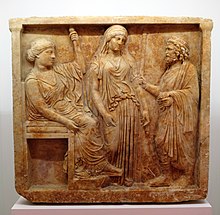Hierophant

A hierophant (Ancient Greek: ἱεροφάντης, romanized: hierophantēs) is a person who brings religious congregants into the presence of that which is deemed holy.[1] As such, a hierophant is an interpreter of sacred mysteries and arcane principles.
The word comes from ancient Greece, where it was constructed from the combination of τὰ ἱερά (ta hiera, 'the holy') and φαίνω (phainō, 'to reveal').
Greek priesthood
[edit]In Attica, Hierophant was the title of the chief priest at the Eleusinian Mysteries. It was an office inherited within the genos of the Eumolpidae, one of the two main clans which managed the Eleusinian cult - the other being the Cerycids.
Eunapius and Vettius Agorius Praetextatus are notable examples.
In modern culture
[edit]Rider Waite tarot
[edit]In the Rider–Waite tarot deck and similar decks, "The Hierophant" (known in the Tarot de Marseille as "The Pope"[2]) is one of the twenty-two trump cards comprising the "Major Arcana", and represents conformity to social standards, or a deference to the established social moral order. As the guide towards knowledge, insight, and wisdom, in a Tarot reading it might, for example, represent a priest, scholar, therapist, or teacher, possibly similar to the Hermit or the King of Cups cards.
A. E. Waite wrote that the Hierophant:
...symbolizes also all things that are righteous and sacred on the manifest side. As such, he is the channel of grace belonging to the world of institution as distinct from that of Nature, and he is the leader of salvation for the human race at large. He is the order and the head of the recognized hierarchy, which is the reflection of another and greater hierarchic order; but it may so happen that the pontiff forgets the significance of his symbolic state and acts as if he contained within his proper measures all that his sign signifies or his symbol seeks to shew [sp] forth. He is not, as it has been thought, philosophy—except on the theological side; he is not inspiration; and his is not religion, although he is a mode of its expression.[2]
In Dungeons & Dragons
[edit]The original Unearthed Arcana supplement to 1st edition AD&D detailed how the 15th-level Grand Druid (the in-game head of all druids) could step down from his position and become a 16th-level Hierophant.[3] In 3rd edition D&D, the hierophant prestige class for high-level divine spellcasters appeared in the Forgotten Realms Campaign Setting and in the 3.5e Dungeon Master's Guide.
See also
[edit] The dictionary definition of hierophant at Wiktionary
The dictionary definition of hierophant at Wiktionary- Daduchos
- Hierophany
- Hierophylakes
- Mystagogue
- Patriarchate
- Pontifex, "bridge-builder" between Heaven and Earth or between the spiritual world and the temporal one
- Sacred mysteries
References
[edit]- ^ "hierophant | Greek priest". Retrieved 2016-09-10.
- ^ a b Waite, A. E. (2012-03-06). The Pictorial Key to the Tarot. Courier Corporation. ISBN 9780486117126.
- ^ Gygax, Gary (1985). Unearthed Arcana. p. 17. ISBN 0880380845.
External links
[edit]- Britannica article
- The last hierophant at Eleusis
- Dictionary definition
- Definition from alt religion Archived 2008-05-16 at the Wayback Machine
